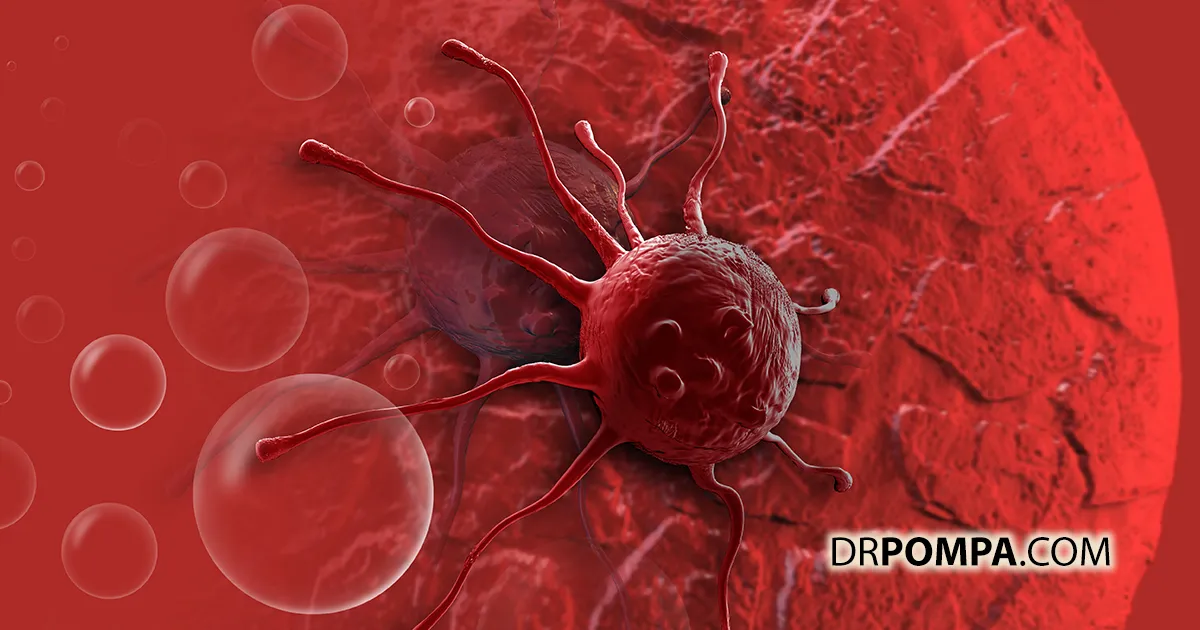In episode 94 of Cellular Healing TV, I had the privilege of interviewing Dr. Thomas Seyfried, the author of “Cancer as a Metabolic Disease.” A professor of biology at Boston College, his research delves deeply into the subject of cancer as a mitochondrial metabolic disease. In addition, he has taught neurogenetics and neurochemistry as it relates to cancer treatment at Yale University and Boston College for the past 25 years. He has also written numerous peer-reviewed science articles and book chapters, as well as authoring his groundbreaking book.
Cancer as a Metabolic Disease
Read Dr. Pompa's full article below the video…
Cancer as a Metabolic Disease
During our interview, Dr. Thomas Seyfried started out by clarifying that he is not claiming to treat cancer or any disease; rather, he feels that current medical treatments are taking the wrong approach. He points out that billions of dollars are being spent on cancer research, and yet, the number of cancer deaths is not changing. In the last 25 years, there has been approximately a 37% increase in new cases and a 3.5 to 4% increase in the number of deaths per year. If the current treatments were successful, you would expect those numbers to drop. Also, in recent years, cancer genomic research has skyrocketed. In fact, it is estimated that there are at least 700 targeted cancer gene therapies… yet none have been shown to reduce tumors.
Cancer Drugs and Theories
The theory of what drives cancer is unbridled cell proliferation (an increase in the number of bad cells), and most of the therapies being used are focusing on halting the proliferation of those cells. The toxic chemicals (chemotherapy) and radiation are used to stop this cycle. Their treatment goal is to damage tumor cell DNA and stop the uncontrolled growth of the cancer cells.
More recently, the field is turning to genomic approach drugs called checkpoint inhibitors (commonly known as immunotherapy drugs). However, few people are getting immunotherapy drugs because they are extremely costly. More importantly, according to Seyfried, these drugs don’t work for the majority of the people and have very significant side effects. And why don’t they work for every cancer patient? Each cancer cell is genetically unique: no two cells in the tumor are alike, nor will they have the same genetic mutations. So why are we focusing on the unique aspects of every cell in the tumor when we can focus on the malady that is common to every cell? We must concentrate on the root causes (R1) of this terrible disease.
Cancer as a Mitochondrial Metabolic Disease
Dr Seyfried’s theory is that cancer is a Mitochondrial Metabolic Disease. For the cell to stay healthy, it is vitally important that the mitochondria (the energy powerhouses of the cell that make ATP aka cellular energy) stay strong and protected. But with the exposure to a myriad of environmental toxins, chemicals, medications and unhealthy eating habits, the cell’s mitochondria can be damaged, which can lead to cellular disaster.
In the early 1900’s, the great Otto Warburg surmised that when damage occurs to the mitochondria, the cell can’t make sufficient energy; therefore, adaptation occurs and it up-regulates a less effective and more primitive form of cellular energy production called glucose fermentation or aerobic glycolysis (the conversion of glucose to lactic acid in the presence of oxygen). With this primitive form of glycolysis, there is less oxygen and more lactic acid, which creates a perfect environment for cancer cells to grow. Warburg also theorized that as cells adapt to damage, “bad” genes get turned on and disease begins expressing.
Seyfried has put Warburg’s theory to the test with many modern day studies, stating with certainty that Warburg is correct: the genomic defect arises as a secondary downstream effect. He believes that cancer is a metabolic disease that uses glucose (and in certain cases glutamine) for energy. Cancer cells do not use fat for energy. Seyfried states that if glucose can be controlled via fasting and ketosis, forcing the cells to use fat for energy, cancer cells would be weakened, giving our immune system or other treatments the upper hand. In Cancer as a Metabolic Disease he states “…It is my opinion that targeting glucose and glutamine under energy restriction will be more effective long-term therapy than any of the current drugs used to treat these cancers.”
What Comes First: the Chicken or the Egg?
Normally, our cellular energy is produced via efficient respiration. But if that system fails, the cell has to gradually increase the capacity to produce ATP energy to remain alive. Thus, the process of glucose fermentation begins.
Oncogenes, which are genes having the potential to cause a normal cell to become cancerous, are highlighted as playing a significant role in the generation of certain cancers. But why are they so central? It turns out that oncogenes control fermentation. They are transcription factors that up-regulate fermentation when respiration becomes insufficient, which leads to extra cellular acidification and wounding to the microenvironment. This then causes inflammation and the progression of other damaging processes.
The bottom line is the chicken came first, or in this case, the cell damage comes before the gene. The mitochondria get damaged and a gene gets turned on for adaptation, creating the perfect environment for cancer to grow.
The Mysterious World of Tumor Cells
Dr Seyfried points out that tumor cell multiplication is a multi-faceted process. The strange thing about tumor cells is that they continue to produce lactic acid, even when oxygen levels are sufficient for respiration. That is happening because the mitochondria are deficient. So those cells behave as if they are in a hypoxic (low oxygen) environment. Despite the fact that they look like they have proper respiration, they don’t.
The acidic environment created by cancer cells is used to market the idea of alkalizing the body. It sounds logical on the surface, that if people with cancer are acidic, let’s make them alkaline. Not so simple, for the reason that the cancer is creating the acidity, and forcing alkalinity doesn’t change this fact. The acid environment is far too downstream. This is a metabolic issue, which I believe is being driven mostly by cellular toxicity.
We must also consider the role that increased glucose plays in tumor cell reproduction. It is critically important to keep glucose levels in normal range. Therefore, one would think that by stopping the cancer cells from using glucose via a medication that stops glycolysis (the use of glucose for energy in states of low oxygen), it could either kill the cells through apoptosis (cell suicide) and/or diminish existing tumors. But that is not necessarily the case. There have been a number of drugs to stop glycolysis (the breakdown of glucose) but they have been unsuccessful. As these drugs stop glycolysis in every cell of the body, this becomes a problem, as both cancer cells and normal cells use the same glycolic pathway. The only difference is that tumor cells are using glucose to a much greater extent. So by using indiscriminant inhibitors of glycolysis, you WILL kill some of the tumor cells, but you will also damage some of the functionality of normal cells.
I am always of the belief that if you go upstream and get to the cause, the body will heal. In this case, we must first stop what damages mitochondria. This is driven either by an increase in glucose driving oxidation and inflammation, or by toxins causing damage, oxidation and inflammation of the fragile mitochondria membranes.
Warburg stated years ago, “Respiratory insufficiency can arise from the cumulative effects of any number of environmental factors that alter mitochondrial function.” So if we control glucose and decrease cellular toxicity via PompaCore Cellular Detox™, what do we do with the damaged mitochondria? Seyfried thinks this is the solution as he notes, “… If all cancer arises from mitochondrial dysfunction, then replacement of damaged mitochondria with normal mitochondria should prevent cancer. In other words, mitochondria producing sufficient respiration should suppress tumor growth regardless of the numbers and types of mutations.”
He refers to his protocols as Mitochondrial Enhancement Therapy (MET), meaning the use of restricted states of eating like fasting and ketosis. These therapies not only heal damaged mitochondria, but also get rid of the bad cells driving tumor formation through two natural processes known as autolysis and autophagy. This is when the body eats bad, damaged cells during times of restriction.
Cancer, Fasting and Ketosis
For cancer management, Seyfried uses fasting and ketosis as “metabolic therapies.” He believes this approach is a promising alternative to chemotherapy and radiation, because the benefits far outweigh the toxic side effects of conventional therapies.
Read more on fasting here and more on the ketogenic diet here. During fasting, and when in a ketotic state, blood glucose is lowered to force cells to burn the body’s own fat for energy, which restricts the glucose available to tumor cells and also increase ketones, which are a powerful and efficient source of energy for proper cellular function.
Seyfried believes one of the benefits of the keto diet is this: because tumors have defective respiration in the mitochondria, tumors can’t use the ketones as their alternative fuel, so they become non-functional. In other words, they become more vulnerable to death as a result of these energetic transitions. This is an elegant way to metabolically marginalize the tumor cells, while enhancing the health and vitality of normal cells.
With the restrictive ketogenic diet, one is trying to manage cancer WITHOUT TOXICITY. And if you understand the metabolism of the body, and are able to tweak metabolic pathways in different directions, one can achieve management of these very difficult diseases without using toxic drugs.
Immunotherapy in the Right Order
Frequently Dr. Seyfried is asked, “Will ketosis and fasting cure cancer?” He would NEVER use the word “cure,” but notes one can manage cancer and slow down the degree of growth. Over time, as the patient utilizes the metabolic protocols with success, he or she can be placed on a schedule of diet variation and a series of less toxic drugs (immunotherapy) that can finish off the surviving tumor cells. The surviving cells become targets for immunotherapy drugs because we are finally dealing with a population of cells that have something in common. It is all about timing. He points out that allopathic medicine is doing a lot of things correctly … just in the wrong order.
Testing Proves Theories
Some exceptional developmental biologists performed numerous tests and studies over many years, testing the hypothesis of whether cancer is a nuclear genetic disease or a mitochondrial metabolic disease. Dr Seyfried bundled all those experiments into one group and presented them for the first time. Here is the conclusion: the nucleus of the tumor cell is NOT capable of driving the disease. It is the mitochondrion that is driving the disease. This is a revolutionary theory.
The Glory of Ketones
Although Dr. Seyfried is an expert in the keto adaptation diet, he also gives much credit to his colleague, Dr. Dominic D’Agostino researcher at the University of South Florida, who is also a global authority in keto-adaptation and a featured guest on CHTV. Keto-adaptation is a form of therapeutic ketosis, not to be confused with ketoacidosis (a pathological state experienced by some diabetic patients). What actually takes place during keto-adaptation? The blood sugar goes down and eventually glycogen reserves in the liver and muscles are used up. Then the body must mobilize fat for energy, primarily using the fat storehouse in the liver, where most of the ketones are generated.
The liver makes these water soluble by-products (little energy ketone bodies) that can be used by the brain and the heart to become energy efficient. But the glories of ketones don’t stop there. Ketone bodies also create healthy and increased mitochondria production. They produce very few reactive oxygen species (ROS), or wasteful energy, and the utilization of this cleaner fuel causes much less cellular inflammation.
During the interview with Dr. Dominic D’Agostino, we discussed another benefit of the keto diet. In new studies, some of which he has done personally, ketones have the ability to change gene expression. In other words, ketones can turn off bad genes that are involved not just in cancer but many other diseases. According to new studies, ketones can also turn on genes that help us live longer.
How Do You Know When You Are in the Keto Zone?
A question many patients ask Dr. Seyfried, “How do I know if I am in the zone of ketosis?” Dr. Seyfried published a paper earlier this year on the glucose ketone index calculator that was designed primarily for cancer patients. Any person who wants to know whether or not they are in a therapeutically ketotic state must use a meter that measures both blood glucose and ketones (The meter we suggest is the Precision Xtra, which can be purchased online).
The perfect keto zone is accessed by taking the ratio of glucose (perfect range is 55-65) divided by the ketone number (perfect range between 3-7) and the perfect ratio is 1.0 or below. The glucose will need to be converted from mg/dl to mmol/L. This can be done on line at conversion.com. If you are within this range, your body is using ketones very efficiently and “eating up” undesirable cells (referred to as the autolytic state). Healthy people with no cancer can get into this zone much easier than those who are ill. Because a cancer diagnosis can produce a lot of anxiety, it can lead to elevated blood sugar levels, and elevated glucose can hinder keto-adaptation. However, if cancer patients can handle the stress of their diagnosis well enough, they are able to get into the zone of keto-adaptation much easier.
Methods for Hitting the Zone and My Personal Experience
Dr. Seyfried explains there are various ways to start using metabolic therapies to hit that perfect zone. A water-only fast for 4-7 days is ideal, but water-only fasting must be monitored closely. I have used beef stock for 4 days and hit the zone with many people, and this is a much easier fast than water only. And of course, the keto adaptation diet, which I refer to as an advanced cellular healing diet is the cornerstone, because over time, it dramatically lowers glucose while increasing health-promoting ketones. In my practice, I combine a ketogenic diet with daily intermittent fasting where the client often fasts for 16-18 hours from dinner to the next meal (a late lunch). Intermittent fasting can greatly support increased ketone production and glucose reduction, and the fact that it is done daily, and not just 4-7 days, produces results that are amazing in regards to hormone health and anti-aging.
I asked Seyfried if he felt moving in and out of the zone is still effective; for example, going into ketosis for 3-4 months then moving back into a regular Cellular Healing Diet (diet variation) or doing 4 day fasts periodically. He said even one or two fasts a year is beneficial for most people. I do believe more time in the zone and more frequent fasting is needed in some cases to regain health. I have many clients who do one fast a month, and with every fast new healing occurs.
I have witnessed, the healing power of one long fast personally with my own wife. Years ago she had some pre-cancerous cervical cells. She water fasted for 12 consecutive days (with my supervision) and returned to the doctor who diagnosed her some months later showing no more cancer cells. The doctors were in shock. To this day, we both periodically utilize 4 day fasts, mostly using whey water or stock. We also go into ketosis throughout the year for 3-4 months at a time, and move back into the Cellular Healing Diet the other months. For the last 2 years we have also utilized intermittent fasting daily with incredible results. I can honestly say that I see and feel like I have gotten 10 years younger. I believe the practice of moving in and out of these restricted states such as fasting, ketosis, and the cellular healing diet, which I refer to as diet variation, emulates our longer living ancestors, turning on our genes for a long healthy life.
Troubleshooting Weight Loss Resistance
But the ketogenic diet is not always smooth sailing, as some can experience weight loss resistance during the course of this diet. This may be as a result of consuming too much protein, fat, or calories. Note that food and drink management will be different for each person. For instance, some cancer patients can manage to drink a glass of dry red wine without spiking their glucose levels. And for some, beef stock will keep them in that perfect adaptation zone and others need only water. The perfect balance of foods and fats is tricky, and that is why you need a trained professional to monitor your progress (for more info on working with a practitioner trained in ketogenic diet therapy call my office).
The first thing I assess if someone says they are gaining weight or not losing weight is to note the amount of carbs they are ingesting. For most, less than 50 grams is effective, but some have to go down lower to lose weight or hit the target zone. The next question I ask is the amount of protein they are consuming daily. Protein can convert to sugar and this will keep people out of ketosis or the zone. Too much fat could also lead to not enough restriction, and can be adjusted by utilizing intermittent fasting daily (taking out one meal), or using 2 small meals in the day and a bigger dinner. It is important to still eat one big meal (to fullness) a day, otherwise the body will think it’s starving and shut down weight loss. Caloric restriction by itself does not work for this reason. You cannot simply push food away each meal. You will fail because the body, in attempt not to starve, will lower the set-point (metabolism) or give you cravings you cannot resist and then the diet is broken. By eating at least one meal a day to full, and restricting during the day, the body will not go into this starvation reaction and instead will learn to become a more efficient fat burner to provide the energy it needs throughout the day.
I don’t eat nearly the amount of calories as others: not because I am pushing away food, but because my cells are very efficient at utilizing fat. I am simple not as hungry. I have observed my clients becoming very proficient at fat burning at the cellular level, and they too don’t need as much food and they eat less naturally. What a relief when food cravings disappear.
Diet Variation is a Must
As noted earlier, Dr. Seyfried and I agree that it is very important to move people in and out of ketosis with a method called diet variation. Also, I have found that for patients who couldn’t get into ketosis, taking them off the keto diet for a few months and starting my Cellular Healing diet can elicit wanted changes. When previously these clients couldn’t lose weight, they were suddenly able to shed pounds once switching diets. I keep them on the Cellular Healing diet for a few months, and then shift them back to the ketogenic diet. After these diet variations, patients have a much easier time getting into the keto zone.
A perfect example of diet variation is the Hunzu people who lived very long disease free lives. Their culture was forced into dramatic dietary shifts. In the summer, they were eating mostly vegetables and fruit. In the winter, they were surviving on fatty foods. Then they had “starvation spring,” when they went weeks or months without much food. Based on the health and vitality of these cultures, we can thrive with diet variation.
Dr. Seyfried notes that shifting back and forth between different diets is exactly what you need to eliminate tumor cells. Tumor cells have a lot of mutations as a secondary consequence of defects in respiration. Tumor cells have all kinds of broken chromosomes, deletions and duplications, and because of these mutations, the tumors are much less adaptable to these dietary shifts. And with this lack of adaptation, they end up getting eliminated. So we can exploit the genetic defects in the tumor cells by forcing these dramatic shifts with diet variation.
What Fats Should I Be Eating?
Healthy fats are key to a successful ketogenic diet. But remember there are different kinds of fats. On the Atkins diet, for example, people take in any kind of fat and as much as possible. The ketogenic diet revolves around a special type of fatty acid called medium chain triglycerides, like coconut oil, MCT oil, and avocados, and doesn’t encourage the consumption of too many long chain fatty acids (fish oil, olive oil). Even though a little bit of fish oil is ok, too many people in this country are omega 3 dominant, consuming rancid fish oils. With omega 3 dominance comes the displacement of cardiolipin out of the mitochondrial membrane, causing energy leaks. So for the bulk of the keto diet, it is best to use medium chain triglycerides for fat since they play an important role in promoting optimal ketone levels.
As stated above, we must remember that eating too much fat (even healthy fats), or food period, can put you in harm’s way. For some people when too much fat or calories is consumed, blood sugar will not decrease, insulin goes up, and the next thing you know, you have very high triglycerides. If blood sugar does not drop, and ketones do not rise, something needs to be adjusted. On the ketogenic diet, I suggest my clients eat 2 tablespoons of organic, grass-fed butter and either 2 tablespoons of raw coconut oil or MCT oil per day, plus quality sea salt to balance electrolytes. It is prudent to follow the healthy fat guidelines provided by your qualified health care professional.
The Use of Exogenous Ketones
Some have asked Dr. Seyfried about the use of exogenous ketones (ketone supplements, or ketones created outside the body). Surely this would be a welcomed short cut. His colleague, Dr. A’gostino, gets good results using exogenous ketones, but we have yet to fully explore this avenue. See more on the subject of exogenous ketones here. I believe exogenous ketones will not replace what our body does naturally during a fast or ketosis, but could be very beneficial in the time that blood sugar is dropping and ketones are not yet rising. We will know more as our doctors’ use them during times of restriction, so stay tuned.
Right now, the natural ones are not easy to make. Richard Veech from the NIH has been working on this for many years. He is one of the world’s authorities in making natural kinds of ketones and his body of work explains how they influence mitochondrial function. But for now, we must mostly rely on metabolic therapies for ketone production.
What Kind of Exercise is Required?
According to Dr. Seyfried, exercise is required in combination with metabolic adaptation diets. However, moderate exercise is the key. No need to torture your body. Why is over-exercising dangerous? If you look at marathon runners, this intense exercise damages the immune system and can create inflammatory conditions that may even provoke the onset of cancer in some people. But moderate exercise enhances mitochondrial function under the right kind of dietary conditions. Short, high intensity training is the best option. I have been teaching high intensity burst training to my patients for years, check out more info on bursting here.
Protect Your Mitochondria (R3)
Dr Seyfried said, “If all cancers arise from metabolic dysfunction, then replacement of damaged mitochondria with normal mitochondria should prevent cancer. In other words, mitochondria producing sufficient respiration (energy) should suppress tumor growth regardless of the numbers and types of mutations.” The logic is that if cancer is a metabolic mitochondrial disease, and you protect your mitochondria, you don’t get cancer. Even if you inherit the Brac 1 gene mutation that damages mitochondria, for example, you can still utilize metabolic therapies to enhance wellbeing. And when you do so, the probability of developing these diseases is significantly reduced. When we put all these therapies together, fasting, daily intermittent fasting, ketosis, and diet variation, we have the tools needed to fix these metabolic problems.
My Multi-Therapeutic Approach
So many people are suffering unnecessarily. I believe that mitochondrial damage is leading not just to cancer, but to a multitude of other diseases, like chronic fatigue syndrome, fibromyalgia, diabetes and thyroid dysfunction, to name a few. In order to achieve health, it is very important to link the above-mentioned therapies together. I call this a Multi-Therapeutic Approach (MTA). This includes my 5R’s of PompaCore Cellular Detox and Healing™, which explains how to fix the cell, my unique PompaCore Cellular Detox™ system where we remove toxins and the interference creating mitochondrial damage, and ancient healing strategies (like fasting and ketosis) and burst training workouts. We need all the tools we can muster to fight these previously untreatable diseases. That is why the information Dr. Seyfried provides is vitally important: it addresses the very basis of what we need to do in order to enjoy vibrant cellular health.
Many Thanks to the Brilliant Dr. Seyfried
I encourage you to buy Dr. Seyfried’s book, Cancer as a Metabolic Disease. There is also a Facebook page for his book for those who want to make contributions directly to his research. The research is being used to enhance the concepts of the book, and eventually, there will be a reasonable therapy for managing cancer without the toxicity. This will empower patients and allow them to be participatory in their own treatment.
Dr. Seyfried’s goal is for cancer patients to finish metabolic therapy healthier than when they started. And this can happen when people understand more about the nature of cancer. What he offers is a strategy for long-term, non-toxic management of the disease. His work is amazing, as it proves in detail what I have been teaching for years. I am so appreciative of all the work and studies he offers for our benefit, an answer to a growing epidemic of cancer and other so-called incurable diseases. Thank you so much for sharing with us your life saving theories, Dr. Seyfried, and may all of you benefit from his remarkable body of work.








